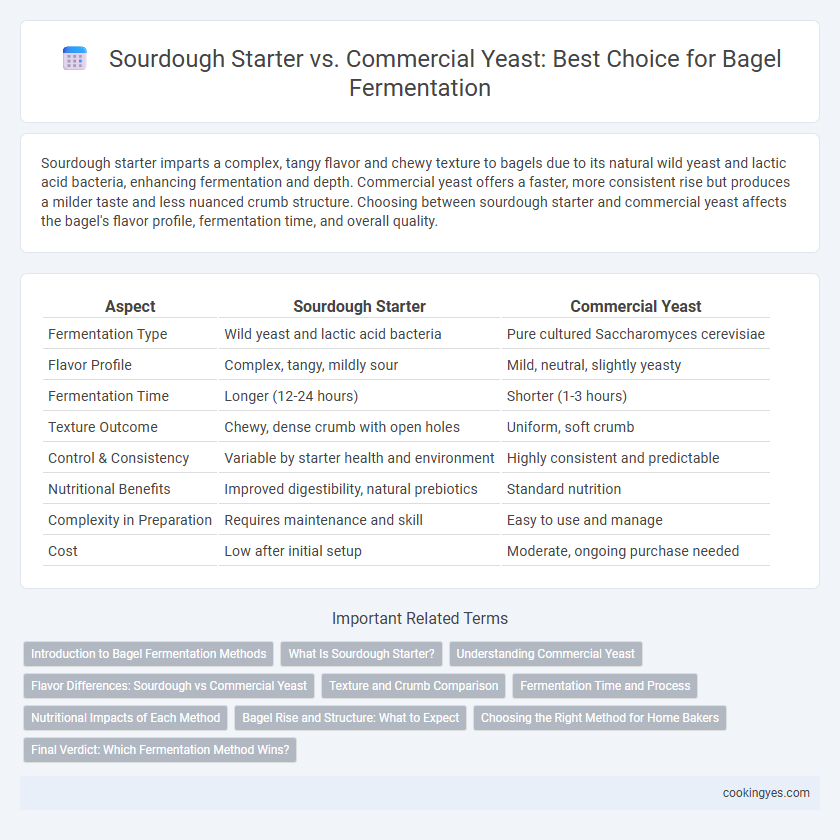Sourdough starter imparts a complex, tangy flavor and chewy texture to bagels due to its natural wild yeast and lactic acid bacteria, enhancing fermentation and depth. Commercial yeast offers a faster, more consistent rise but produces a milder taste and less nuanced crumb structure. Choosing between sourdough starter and commercial yeast affects the bagel's flavor profile, fermentation time, and overall quality.
Table of Comparison
| Aspect | Sourdough Starter | Commercial Yeast |
|---|---|---|
| Fermentation Type | Wild yeast and lactic acid bacteria | Pure cultured Saccharomyces cerevisiae |
| Flavor Profile | Complex, tangy, mildly sour | Mild, neutral, slightly yeasty |
| Fermentation Time | Longer (12-24 hours) | Shorter (1-3 hours) |
| Texture Outcome | Chewy, dense crumb with open holes | Uniform, soft crumb |
| Control & Consistency | Variable by starter health and environment | Highly consistent and predictable |
| Nutritional Benefits | Improved digestibility, natural prebiotics | Standard nutrition |
| Complexity in Preparation | Requires maintenance and skill | Easy to use and manage |
| Cost | Low after initial setup | Moderate, ongoing purchase needed |
Introduction to Bagel Fermentation Methods
Sourdough starter fermentation for bagels relies on naturally occurring wild yeast and lactic acid bacteria, offering a complex flavor profile and chewier texture through slower fermentation. Commercial yeast, predominantly Saccharomyces cerevisiae, ensures rapid and consistent CO2 production, resulting in faster dough rise and uniform crumb structure. Choosing between sourdough starter and commercial yeast impacts fermentation time, flavor development, and the final bagel's texture.
What Is Sourdough Starter?
Sourdough starter is a natural leavening agent composed of wild yeast and lactic acid bacteria cultivated from flour and water. It ferments slowly, producing complex flavors and a characteristic tang in bagels due to organic acids and long fermentation times. Unlike commercial yeast, sourdough starter enhances gluten development and improves shelf life by fostering a robust microbial ecosystem.
Understanding Commercial Yeast
Commercial yeast, primarily Saccharomyces cerevisiae, is a highly active leavening agent widely used for bagel fermentation due to its consistent and predictable fermentation rates. Unlike sourdough starter, commercial yeast offers rapid carbon dioxide production that contributes to a uniform rise and a denser crumb structure typical of traditional bagels. Its standardized formulation ensures reproducibility in texture and flavor, making it a preferred choice in commercial bagel production environments.
Flavor Differences: Sourdough vs Commercial Yeast
Sourdough starter imparts a complex, tangy flavor to bagels due to its natural fermentation process involving wild yeast and lactic acid bacteria, which enhances depth and aroma. Commercial yeast produces a milder, more predictable taste with a cleaner, slightly sweet profile but lacks the nuanced sourness characteristic of sourdough. The extended fermentation time in sourdough also contributes to a chewier texture and richer flavor complexity compared to the quicker rise with commercial yeast.
Texture and Crumb Comparison
Sourdough starter fermentation produces bagels with a chewier texture and a more complex, open crumb structure due to natural wild yeast and lactic acid bacteria activity. Commercial yeast typically results in a denser crumb and a softer bite, as its rapid fermentation lacks the time for intricate flavor and texture development. The longer fermentation with sourdough enhances gluten structure and moisture retention, creating a signature crust and layered interior distinct from commercial yeast bagels.
Fermentation Time and Process
Sourdough starter fermentation for bagels typically requires 12 to 24 hours, allowing natural wild yeast and bacteria to develop complex flavors and a chewier texture. Commercial yeast accelerates the process, usually fermenting in 1 to 2 hours, producing a milder taste and softer crumb. Longer fermentation with sourdough also improves crust development and shelf life due to organic acid production.
Nutritional Impacts of Each Method
Sourdough starter fermentation enhances bagel nutritional value by increasing bioavailability of minerals such as iron and zinc through natural lactic acid bacteria activity, promoting gut health with beneficial probiotics. Commercial yeast, primarily Saccharomyces cerevisiae, produces faster fermentation but results in lower nutrient complexity and fewer probiotics, leading to less impact on digestive health. The slower sourdough process also reduces phytates, improving mineral absorption, which is typically less effective in commercial yeast-fermented bagels.
Bagel Rise and Structure: What to Expect
Sourdough starter produces a slower, longer fermentation that enhances bagel rise with complex flavors and a chewier texture due to natural wild yeast and lactic acid bacteria activity. Commercial yeast creates a faster, more consistent rise, yielding a lighter crumb and uniform structure but lacks the depth of tang and firmness characteristic of sourdough. The choice between sourdough starter and commercial yeast directly impacts bagel chewiness, crust thickness, and overall taste profile.
Choosing the Right Method for Home Bakers
Sourdough starter imparts a complex, tangy flavor and chewy texture to bagels through natural wild yeast fermentation, enhancing depth and shelf life. Commercial yeast offers consistent rise times and simplicity, making it ideal for home bakers seeking reliable results without lengthy preparation. Choosing between sourdough and commercial yeast depends on desired taste complexity, time availability, and baking experience, with sourdough favoring flavor enthusiasts and commercial yeast suiting convenience-focused bakers.
Final Verdict: Which Fermentation Method Wins?
Sourdough starter imparts a complex tangy flavor and chewy texture to bagels through natural wild yeast and lactic acid bacteria fermentation, resulting in a more artisanal and flavorful product. Commercial yeast offers rapid fermentation and consistent results, making it ideal for mass production but often lacking depth in flavor and texture. For those prioritizing authenticity and nuanced taste, sourdough starter fermentation is the winning method, whereas commercial yeast suits high-volume, fast-turnaround bagel production.
Sourdough Starter vs Commercial Yeast for Bagel Fermentation Infographic

 cookingyes.com
cookingyes.com